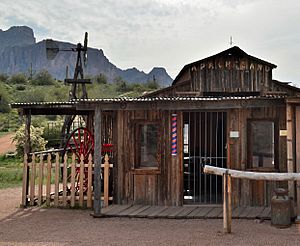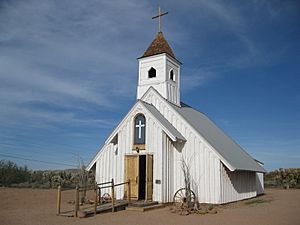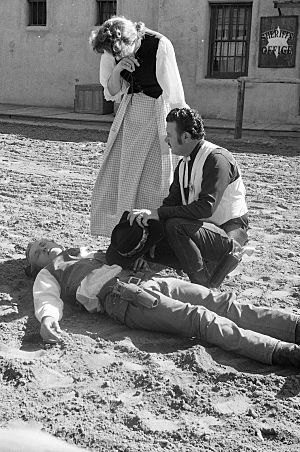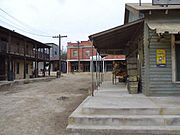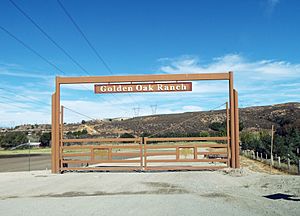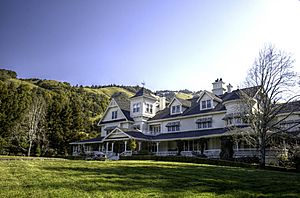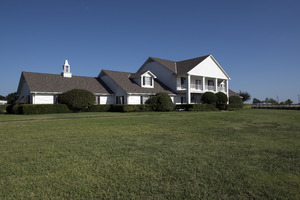Movie ranch facts for kids
A movie ranch is a special kind of ranch used as a giant outdoor set for making motion pictures and television shows. Most of the first movie ranches were built in Southern California because the sunny weather was perfect for filming year-round.
These ranches became popular in the 1920s, especially for filming Westerns. Movie studios found it was easier to film in the wide-open valleys and canyons of California than to build fake landscapes on a studio backlot. Big movies, like war films, also needed these large, natural spaces for battle scenes.
How Movie Ranches Got Started
In the early days of Hollywood, filming in faraway places like Arizona or Nevada was expensive. Studios had to pay workers extra to travel. To save money, studios bought large pieces of land closer to Hollywood. These ranches were usually within a 30-mile area, in places like the San Fernando Valley and the Santa Monica Mountains. The natural hills and rocks were a perfect background for all kinds of stories.
After World War II, cities in Southern California grew bigger. Land became more expensive, and many of the old movie ranches were sold and turned into neighborhoods. However, some were saved and turned into public parks. People can visit them today, and they are still sometimes used for filming.
Famous Movie Ranches of the Past
Apacheland Movie Ranch
Located in Apache Junction, Arizona, Apacheland opened in 1960. It was created to be the "Western Movie Capitol of the World." Many famous actors filmed here, including Elvis Presley, Ronald Reagan, and Audie Murphy. Movies and TV shows like Charro! and Death Valley Days were filmed at Apacheland.
Sadly, a fire in 1969 destroyed many of the sets, but they were rebuilt. A second fire in 2004 destroyed most of the ranch for good. Two buildings that survived, the "Elvis Chapel" and a barn, were moved to the Superstition Mountain Museum, where they can be seen today.
Columbia Ranch – Warner Bros. Ranch
This ranch in Burbank, California, was first owned by Columbia Pictures and later by Warner Bros. It was the backdrop for many classic TV shows. The houses from Father Knows Best, Bewitched, and I Dream of Jeannie were all on this lot. It was also where The Monkees and The Partridge Family were filmed.
Many famous movies used the ranch, including High Noon, The Wild One, and Cat Ballou. In 2023, the property was sold, and the historic sets and sound stages were torn down to make way for new office space for the studio.
Corriganville Movie Ranch
In 1937, actor Ray "Crash" Corrigan bought land in Simi Valley and turned it into a movie ranch. He built a Western town, a fort, a Mexican village, and more. The ranch was used for hundreds of movies, including Fort Apache. The TV show The Adventures of Rin Tin Tin also filmed here.
In 1949, Corrigan opened the ranch to the public on weekends as an amusement park. After it was sold to comedian Bob Hope in 1966, a wildfire destroyed the sets in 1970. Today, the area is a public park where you can still see the foundations of the old movie sets.
Iverson Movie Ranch
The Iverson family began letting film crews use their farm in Chatsworth as early as 1912. The ranch's rocky hills and winding roads made it a perfect location for Westerns, adventure movies, and TV shows. It was used to film parts of Africa, the Middle East, and other exotic places.
Thousands of movies and TV shows were filmed here, including The Lone Ranger, The Roy Rogers Show, and Zorro. In the 1960s, a new freeway was built right through the middle of the ranch, which made filming difficult. The ranch was eventually sold and developed. Today, part of the ranch is a park called the Garden of the Gods, where visitors can see the famous rocks from old movies.
Lasky Movie Ranch – Ahmanson 'Lasky Mesa' Ranch
This huge ranch was used for some of Hollywood's biggest movies. Scenes from Gone with the Wind and They Died with Their Boots On were filmed on its mesas. The land was almost turned into a new housing development in the 1990s.
However, many people worked to protect the land. It was eventually purchased by the state and turned into the Upper Las Virgenes Canyon Open Space Preserve. The public can now hike on trails through the same land where classic movies were made.
Monogram Ranch/Melody Ranch
This ranch near Santa Clarita, California, was first known as Monogram Ranch. In 1953, the famous singing cowboy Gene Autry bought it and renamed it Melody Ranch, after one of his movies. It was a popular spot for filming Westerns.
In 1962, a wildfire burned down most of the Western town sets. For years, the damaged land was used to film shows like Combat!. In 1990, the Veluzat family bought the ranch and rebuilt the sets. Today, it is an active movie studio called Melody Ranch Studios and was used for films like Django Unchained. It also has a museum and hosts a cowboy festival every year.
Paramount Movie Ranch
In 1927, Paramount Studios bought 2,700 acres in the Santa Monica Mountains. They built amazing sets, including a replica of old San Francisco and a Spanish Hacienda set. The Western town on the ranch was used for TV shows like Bat Masterson and Dr. Quinn, Medicine Woman.
In 1980, the National Park Service took over the ranch and opened it to the public. It was still used for filming, including for the popular TV show Westworld. Sadly, in November 2018, the Woolsey Fire destroyed almost all of the historic buildings. Efforts were made to raise money to rebuild the sets.
RKO Encino Ranch
The RKO Encino Ranch was a large 89-acre (360,000 m2) lot in Encino. It was first used for the award-winning 1931 movie Cimarron. RKO built many different sets on the ranch, including a New York City street, a medieval Paris, and the fictional town of Bedford Falls for the Christmas classic It's a Wonderful Life.
Other famous movies filmed here include King Kong and Citizen Kane. By the 1950s, the city of Los Angeles had grown around the ranch. In 1954, the property was sold and turned into a housing neighborhood. None of the original sets remain.
Walt Disney's Golden Oak Ranch
In 1959, Walt Disney bought this ranch in Placerita Canyon to make sure his studio would always have a place for outdoor filming. He named it after the "Oak of the Golden Dream," a tree where gold was first discovered in California.
The ranch has been used in many Disney productions over the years. Classic movies like Old Yeller and The Parent Trap were filmed here, as well as modern blockbusters like Pirates of the Caribbean. The ranch is still owned by The Walt Disney Company and is an active filming location.
Spahn Movie Ranch
The Spahn Ranch was a 55-acre (22 ha) property in the hills above Chatsworth. It was used to film many Westerns in the 1940s and 1950s, including episodes of Bonanza and The Lone Ranger.
In the late 1960s, the ranch was not used for filming as much. The owner, George Spahn, allowed a group known as the Manson Family to live on the property in exchange for helping with chores. The ranch became known as the group's headquarters during a time they were involved in serious crimes in 1969. A wildfire in 1970 destroyed all the film sets. Today, the land is part of a state park.
20th Century Fox Movie Ranch
This ranch in the Santa Monica Mountains was bought by 20th Century Fox in 1946. It became famous as the main filming location for the movie MASH and the popular TV series M*A*S*H. The iconic signpost from the show was located here. The ranch was also used for the Planet of the Apes movie and TV series.
In 1976, the land was sold to become part of Malibu Creek State Park. Today, visitors can hike to the old M*A*S*H set location.
Other Filming Locations
Pioneertown
Pioneertown is a unique town in California's Mojave Desert. It was built in the 1940s as a movie set that actors could also live in. Their houses were designed to look like part of an Old West town, so they could be used in films. Famous cowboys like Roy Rogers and Gene Autry filmed their movies and TV shows here. Pioneertown is still a tourist attraction today, where visitors can walk down the old movie-set streets.
Skywalker Ranch
This is not a movie ranch for filming outdoor scenes. It is the filmmaking headquarters of George Lucas, the creator of Star Wars. Located in Northern California, Skywalker Ranch is where the sound effects, music, and editing for many famous movies are done. The property is very large, but most of it is kept as undeveloped, natural land.
Southfork Ranch
This ranch in Parker, Texas, became world-famous as the home of the Ewing family in the popular 1980s TV show Dallas. While most of the show was filmed in a studio, the ranch was used for all the outside shots of the house and grounds. Today, Southfork Ranch is a popular tourist attraction and event center.


